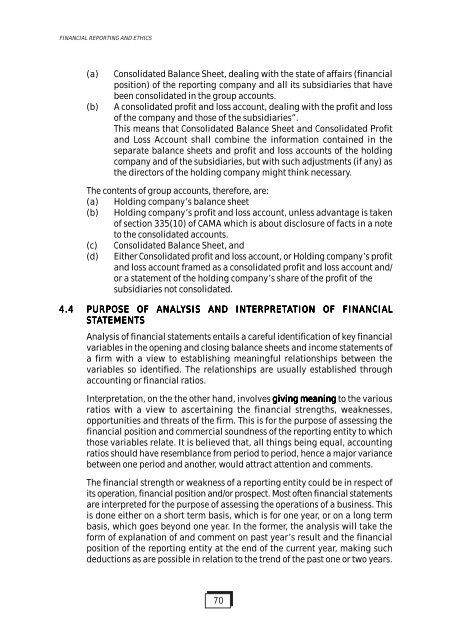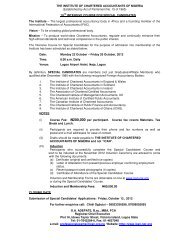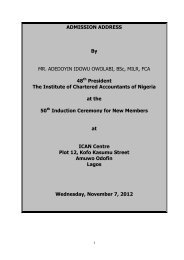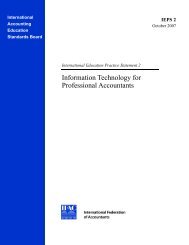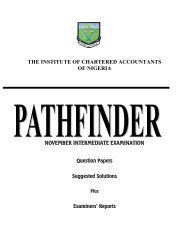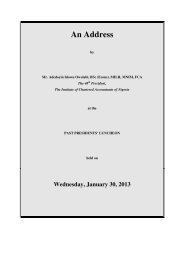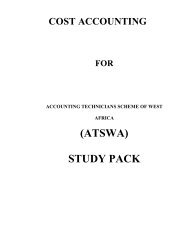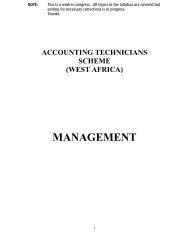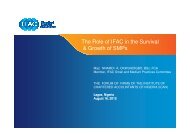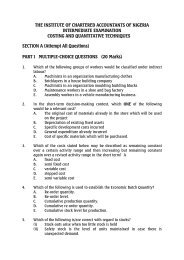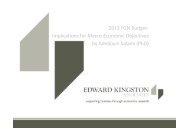Financial Reporting and Ethics - The Institute of Chartered ...
Financial Reporting and Ethics - The Institute of Chartered ...
Financial Reporting and Ethics - The Institute of Chartered ...
- No tags were found...
You also want an ePaper? Increase the reach of your titles
YUMPU automatically turns print PDFs into web optimized ePapers that Google loves.
FINANCIAL REPORTING AND ETHICS(a)(b)Consolidated Balance Sheet, dealing with the state <strong>of</strong> affairs (financialposition) <strong>of</strong> the reporting company <strong>and</strong> all its subsidiaries that havebeen consolidated in the group accounts.A consolidated pr<strong>of</strong>it <strong>and</strong> loss account, dealing with the pr<strong>of</strong>it <strong>and</strong> loss<strong>of</strong> the company <strong>and</strong> those <strong>of</strong> the subsidiaries”.This means that Consolidated Balance Sheet <strong>and</strong> Consolidated Pr<strong>of</strong>it<strong>and</strong> Loss Account shall combine the information contained in theseparate balance sheets <strong>and</strong> pr<strong>of</strong>it <strong>and</strong> loss accounts <strong>of</strong> the holdingcompany <strong>and</strong> <strong>of</strong> the subsidiaries, but with such adjustments (if any) asthe directors <strong>of</strong> the holding company might think necessary.<strong>The</strong> contents <strong>of</strong> group accounts, therefore, are:(a) Holding company’s balance sheet(b) Holding company’s pr<strong>of</strong>it <strong>and</strong> loss account, unless advantage is taken<strong>of</strong> section 335(10) <strong>of</strong> CAMA which is about disclosure <strong>of</strong> facts in a noteto the consolidated accounts.(c) Consolidated Balance Sheet, <strong>and</strong>(d) Either Consolidated pr<strong>of</strong>it <strong>and</strong> loss account, or Holding company’s pr<strong>of</strong>it<strong>and</strong> loss account framed as a consolidated pr<strong>of</strong>it <strong>and</strong> loss account <strong>and</strong>/or a statement <strong>of</strong> the holding company’s share <strong>of</strong> the pr<strong>of</strong>it <strong>of</strong> thesubsidiaries not consolidated.4.4 PURPOSE OF ANALYSIS AND INTERPRETATION TION OF FINANCIALSTATEMENTSTEMENTSAnalysis <strong>of</strong> financial statements entails a careful identification <strong>of</strong> key financialvariables in the opening <strong>and</strong> closing balance sheets <strong>and</strong> income statements <strong>of</strong>a firm with a view to establishing meaningful relationships between thevariables so identified. <strong>The</strong> relationships are usually established throughaccounting or financial ratios.Interpretation, on the the other h<strong>and</strong>, involves giving meaning to the variousratios with a view to ascertaining the financial strengths, weaknesses,opportunities <strong>and</strong> threats <strong>of</strong> the firm. This is for the purpose <strong>of</strong> assessing thefinancial position <strong>and</strong> commercial soundness <strong>of</strong> the reporting entity to whichthose variables relate. It is believed that, all things being equal, accountingratios should have resemblance from period to period, hence a major variancebetween one period <strong>and</strong> another, would attract attention <strong>and</strong> comments.<strong>The</strong> financial strength or weakness <strong>of</strong> a reporting entity could be in respect <strong>of</strong>its operation, financial position <strong>and</strong>/or prospect. Most <strong>of</strong>ten financial statementsare interpreted for the purpose <strong>of</strong> assessing the operations <strong>of</strong> a business. Thisis done either on a short term basis, which is for one year, or on a long termbasis, which goes beyond one year. In the former, the analysis will take theform <strong>of</strong> explanation <strong>of</strong> <strong>and</strong> comment on past year’s result <strong>and</strong> the financialposition <strong>of</strong> the reporting entity at the end <strong>of</strong> the current year, making suchdeductions as are possible in relation to the trend <strong>of</strong> the past one or two years.70


